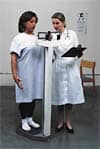A study of pregnant women shows that restless legs syndrome (RLS) is common and is strongly associated with poor sleep quality, excessive daytime sleepiness, and poor daytime function, which are frequent complaints during pregnancy.
Results show that 36% of women in their third trimester had RLS, and half of the women with RLS had moderate to severe symptoms. Compared with pregnant women without RLS, those with RLS were twice as likely to report poor sleep quality and poor daytime function, and they were also more likely to have excessive daytime sleepiness. Additionally, the study found a positive dose-response relationship between RLS severity and the sleep-wake disturbances.
“While we expected that RLS would be relatively common in pregnant women, we were surprised to observe just how many had a severe form,” says lead author Galit Levi Dunietz, PhD, a T32 post-doctoral research fellow at the University of Michigan Sleep Disorders Center in Ann Arbor, in a release. “These women experienced RLS symptoms at least 4 times per week.”
Study results are published in the July 15 issue of the Journal of Clinical Sleep Medicine.
The study involved 1,563 pregnant women with an average age of 30 years, each of whom was in her third trimester. RLS was diagnosed using the standardized criteria of self-reported symptoms and frequency. Demographic and pregnancy data were extracted from medical records, and sleep information was collected with questionnaires. The study found no evidence for any association between RLS and delivery outcomes.
According to the authors, healthcare providers often dismiss patient complaints of poor sleep and daytime sleepiness during pregnancy.
“These sleep-wake disturbances are considered common symptoms in pregnancy and are frequently attributed to physiological changes that occur in normal pregnancy, but our data suggest that RLS is an additional contributor to these symptoms,” says Dunietz.
The authors suggest that the identification and treatment of RLS in pregnancy—using non-pharmacological approaches—may alleviate the burden of these symptoms for many women.
Infographic credit: Dunietz GL, et al. J Clin Sleep Med. 2017;13(7):863-870. American Academy of Sleep Medicine.




Such an undiagnosed dissesse. Obstetricians are really not aware of this burden.
This disease really is not well stated. We are studying and trying new possibilities in our sleep core